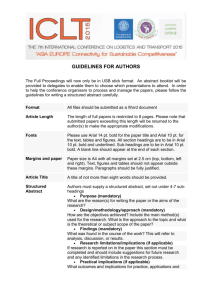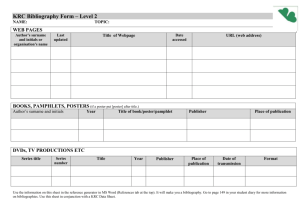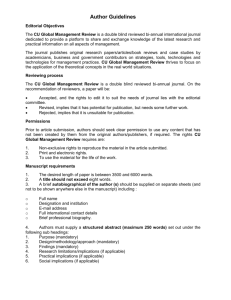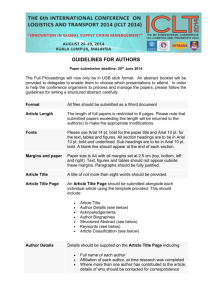author style
advertisement
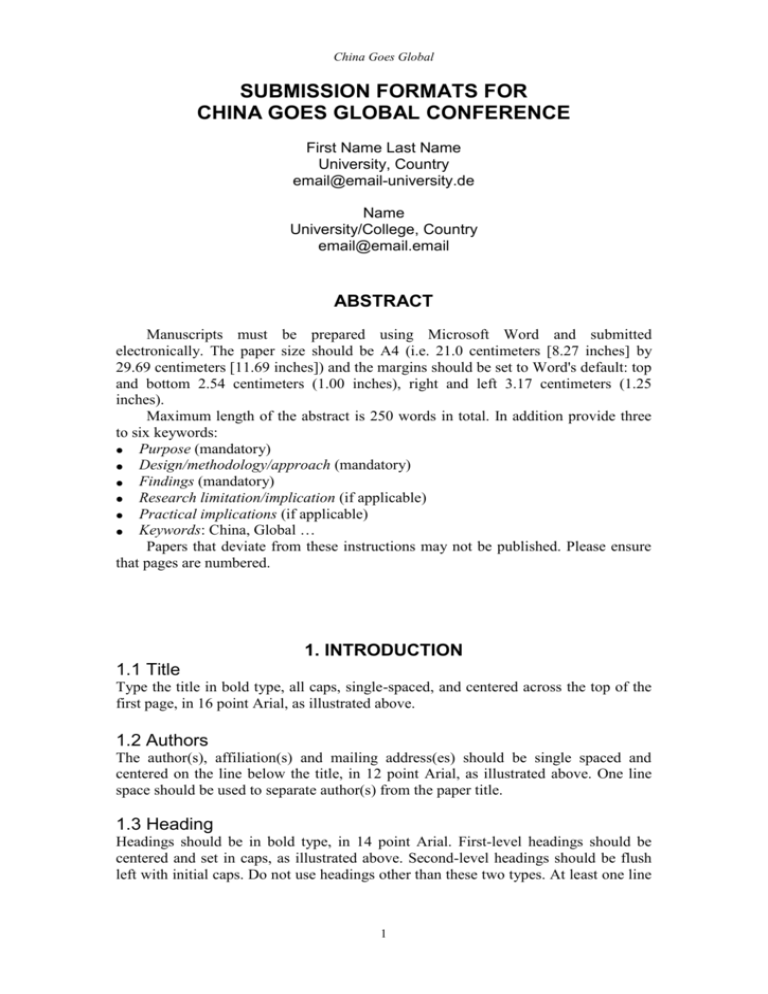
China Goes Global SUBMISSION FORMATS FOR CHINA GOES GLOBAL CONFERENCE First Name Last Name University, Country email@email-university.de Name University/College, Country email@email.email ABSTRACT Manuscripts must be prepared using Microsoft Word and submitted electronically. The paper size should be A4 (i.e. 21.0 centimeters [8.27 inches] by 29.69 centimeters [11.69 inches]) and the margins should be set to Word's default: top and bottom 2.54 centimeters (1.00 inches), right and left 3.17 centimeters (1.25 inches). Maximum length of the abstract is 250 words in total. In addition provide three to six keywords: Purpose (mandatory) Design/methodology/approach (mandatory) Findings (mandatory) Research limitation/implication (if applicable) Practical implications (if applicable) Keywords: China, Global … Papers that deviate from these instructions may not be published. Please ensure that pages are numbered. 1. INTRODUCTION 1.1 Title Type the title in bold type, all caps, single-spaced, and centered across the top of the first page, in 16 point Arial, as illustrated above. 1.2 Authors The author(s), affiliation(s) and mailing address(es) should be single spaced and centered on the line below the title, in 12 point Arial, as illustrated above. One line space should be used to separate author(s) from the paper title. 1.3 Heading Headings should be in bold type, in 14 point Arial. First-level headings should be centered and set in caps, as illustrated above. Second-level headings should be flush left with initial caps. Do not use headings other than these two types. At least one line 1 Title of your paper 2 space to separate first level headings from the text. No additional line space is needed between first-level and second-level headings. 2. BODY All body paragraphs should begin flush left (no paragraph indent) and right justified. Single-space the body of the paper. Use 12 point Times New Roman throughout. Equations, figures and tables should be placed as close as possible to where they are cited. All equations, tables and figures should be embedded into the file and formatted as the following. k q km r q k 2m m 2m (1) L2 L3 L1 T Figure 1. A two-dimensional Blakley’s secret sharing scheme Table 1. BCRs of different JPEG QF attacks on image LENA QF Quality less or equal to 60 BCR Undetected 65 70 75 80 85 90 95 100 89.8% 100% 100% 100% 100% 100% 100% 100% 3. LENGTH REQUIREMENTS Papers submitted to the China Goes Global Conference should not exceed 15 pages. 4. CITATION In-Text citation: 1. In the text, where the author's name appears, the date should follow in parentheses, e.g., Fetscherin (2005). If the author's name is not present in the text, insert it with the author's name and date in parentheses, e.g., (Alon, 2003). 2. Multiple references should be listed alphabetically in parentheses, separated by semicolons, e.g., (Chang, 2002; McIntyre, 2007). 3. Page numbers to indicate a passage of special relevance or to give the source of a quotation or paraphrase should appear in parentheses, e.g., (Lattemann, 2005, p. 12). 4. If there is more than one reference to the same author in the same year, postscript the date of each reference with a, b, c, etc., e.g., (Fetscherin, 2007a; 2007b). Author’s Name 3 5. For references with two authors, give both names every time you cite it, e.g., (Alon & McIntyre, 2004). 6. References with three or more authors, the mention the first author followed by et al. (Chang, et al. 2005). 5. REFERENCES References: Need to be in Harvard style and carefully checked for completeness, accuracy and consistency. For books: Surname, Initials (year), Title of Book, Publisher, Place of publication. e.g. Chang, J. (2005), Economic Reform and Cross-Strait Relations: Taiwan and China in the WTO, World Scientific, New York, NY. For book chapters: Surname, Initials (year), "Chapter title", Editor's Surname, Initials (Ed.), Title of Book, Publisher, Place of publication, pages. e.g. Calabrese, F.A. (2005), "The early pathways: theory to practice – a continuum", in Stankosky, M. (Ed.), Creating the Discipline of Knowledge Management, Elsevier, New York, NY, pp. 15-20. For journals: Surname, Initials (year), "Title of article", Journal Name, volume, number, pages. e.g. Capizzi, M.T. and Ferguson, R. (2005), "Loyalty trends for the twenty-first century", Journal of Consumer Marketing, Vol. 22 No. 2, pp. 72-80. For published conference proceedings: Surname, Initials (year of publication), "Title of paper", in Surname, Initials (Ed.), Title of published proceeding which may include place and date(s) held, Publisher, Place of publication, Page numbers. e.g. Jakkilinki, R., Georgievski, M. and Sharda, N. (2007), "Connecting destinations with an ontology-based e-tourism planner", in Information and communication technologies in tourism 2007 proceedings of the international conference in Ljubljana, Slovenia, 2007, Springer-Verlag, Vienna, pp. 12-32. For unpublished conference proceedings: Surname, Initials (year), "Title of paper", paper presented at Name of Conference, date of conference, place of conference, available at: URL if freely available on the internet (accessed date). E.g. Aumueller, D. (2005), "Semantic authoring and retrieval within a wiki", paper presented at the European Semantic Web Conference (ESWC), 29 May-1 June, Heraklion, Crete, available at: http://dbs.unileipzig.de/file/aumueller05wiksar.pdf (accessed 20 February 2007). For working papers: Surname, Initials (year), "Title of article", working paper [number if available], Institution or organization, Place of organization, date. e.g. Moizer, P. (2003), "How published academic research can inform policy decisions: the case of mandatory rotation of audit appointments", working paper, Leeds University Business School, University of Leeds, Leeds, 28 March. For encyclopedia entries (with no author or editor): Title of Encyclopedia (year) "Title of entry", volume, edition, Title of Encyclopedia, Publisher, Place of publication, pages. e.g. Encyclopaedia Britannica (1926) "Psychology of culture contact", Vol. 1, 13th ed., Encyclopaedia Britannica, London and New York, NY, pp. 765-71. (For authored entries please refer to book chapter guidelines above.) For newspaper articles (authored): Surname, Initials (year), "Article title", Newspaper, date, pages. e.g. Smith, A. (2008), "Money for old rope", Daily News, 21 January, pp. 1, 3-4. For newspaper articles (non-authored): Newspaper (year), "Article title", date, pages. e.g. Daily News (2008), "Small change", 2 February, p. 7. 3 Title of your paper 4 For electronic sources: if available online the full URL should be supplied at the end of the reference, as well as a date that the resource was accessed. e.g. Castle, B. (2005), "Introduction to web services for remote portlets", available at: http://www-128.ibm.com/developerworks/library/ws-wsrp/ (accessed 12 November 2007). Standalone URLs, i.e. without an author or date, should be included either within parentheses within the main text, or preferably set as a note (roman numeral within square brackets within text followed by the full URL address at the end of the paper). APPENDIX The appendix should immediately follow the body and the references of the paper.

